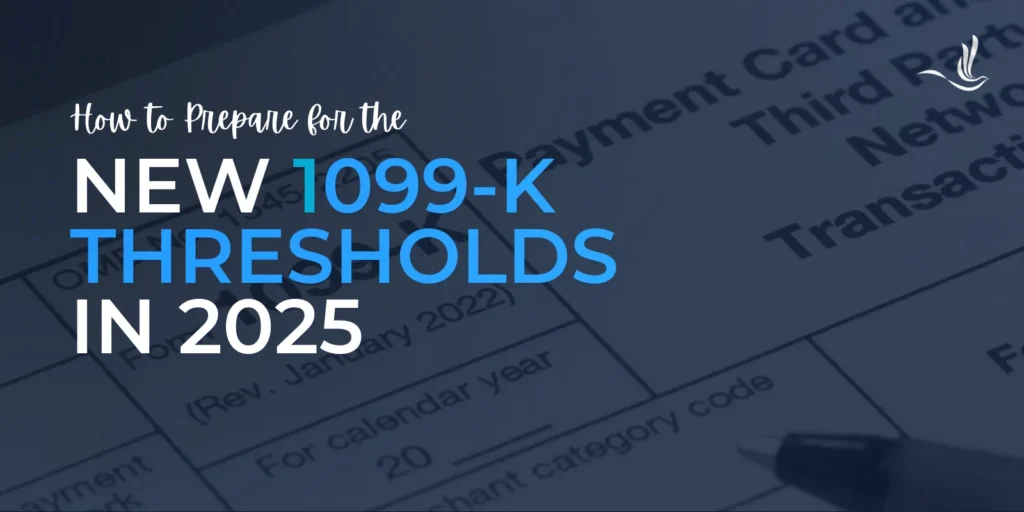
The IRS will enforce new reporting thresholds for 1099-K forms starting in 2025 under the One Big Beautiful Bill Act (OBBBA). The changes will impact gig workers, freelancers, and small business owners, particularly those operating in the gig economy or e-commerce. Understanding these updates and planning accordingly can help avoid surprises come tax season. Let’s break down what’s changing with the 1099-K thresholds, why it matters, and what you should do to prepare.
What Is a 1099-K Form?
A 1099-K is a tax form used to report payments made to you via third-party networks or payment platforms like PayPal, Venmo, eBay, Etsy, and others. Previously, this form was mainly issued to those receiving substantial income through these platforms. While the IRS had planned to lower reporting thresholds in recent years, new legislation has restored the higher original limits.
What’s Changing in 2025?
In 2024, you receive a 1099-K only if you earn $5,000 or more with a single payment processor. The new 2025 rule was set to slash this threshold to $2,500 in total payments, regardless of the number of transactions. The One Big Beautiful Bill Act, which passed in July 2025, permanently reinstates the original reporting threshold of over $20,000 in total payments and more than 200 transactions per calendar year. Those lower 1099-K limits were introduced under the American Rescue Plan Act (ARP) of 2021, which aimed to increase reporting for digital payments. However, after multiple delays and widespread concerns about burdening casual sellers, Congress reversed the change through the OBBBA.
In other words, under the new law, the $20,000-and-200-transactions threshold now applies retroactively to 2022 and beyond, ensuring consistency for taxpayers and third-party platforms.
Why Does the New Threshold Matter?
This change means far fewer taxpayers will receive Form 1099-K in 2025. The restoration of the higher threshold relieves casual sellers, people splitting expenses with friends, and users of digital payment apps from unnecessary tax reporting. Still, all taxable income, whether reported on a 1099-K or not, must be included on your tax return.
The IRS uses Form 1099-K to track payments received through third-party networks and reduce underreported income. With the reinstated thresholds, the focus shifts back to individuals and businesses engaging in substantial online or gig-economy activity, not casual users.
How to Prepare for the New 1099-K Threshold
Even though fewer taxpayers will receive the form, you are still required to report all taxable income, regardless of whether you receive a 1099-K. Here are ways to stay organized and compliant.
Keep Detailed Records of All Income
Tracking your income remains essential. Use accounting software or apps to record all payments from clients, even those made through personal apps. For example, let’s say you’re a freelance graphic designer who receives $10,000 via PayPal and $8,000 via Venmo. Since your total per platform is under $20,000 and fewer than 200 transactions, you will not receive a 1099-K. However, it’s critical to note that the income is still taxable and must be reported.
Review How You Get Paid
Even personal payments can appear as business transactions if not separated correctly. Maintain distinct business and personal accounts on payment platforms to avoid confusion. For example, if you collect rent from a roommate and also receive business payments in the same Venmo account, those combined totals could cause reporting inaccuracies. Keeping accounts separate ensures clarity and accurate records.
Evaluate Your Tax Withholding and Estimated Payments
Whether or not you receive a 1099-K, self-employed workers and gig earners must make quarterly estimated payments to cover tax obligations. The OBBBA doesn’t change your tax liability. It simply affects who receives the reporting form. If your income has increased, adjust your estimated payments or withholding accordingly to avoid a surprise bill at tax time.
Understand Business Deductions
The 1099-K reports gross payment totals, not net income. Continue documenting deductible expenses such as mileage, software, supplies, and other business costs to offset your taxable income. For instance, if you’re a photographer earning $50,000 through Stripe, you can deduct travel, camera equipment, and marketing expenses to reduce your overall tax liability.
Monitor Reporting Platforms
Even though fewer 1099-Ks will be issued, make sure payment platforms have your correct information and report accurately. If you meet both the $20,000 and 200 transactions thresholds, confirm that your form matches your records. Be sure to contact the platform for corrections if needed.
What Happens if You Ignore the Changes?
Failing to report all income, whether you receive a 1099-K or not, can trigger penalties and IRS notices. The reinstated threshold simply means fewer taxpayers will automatically receive reporting forms, not that income is exempt from taxation. Keeping accurate records and filing completely remains your responsibility.
Tax Help for Small Businesses
The One Big Beautiful Bill Act keeps the $20,000-and-200-transactions threshold in place for Form 1099-K reporting. This change is effective retroactively to 2022 and for all years going forward. By understanding these changes, maintaining accurate records, and consulting a tax professional, you can prepare yourself for smoother tax seasons in 2025 and beyond. Implementing these strategies will not only keep you compliant but also minimize the risk of underreporting income, IRS notices, and unexpected tax bills. If dealing with the IRS on your own is intimidating, consider consulting with a tax professional for help. Optima Tax Relief is the nation’s leading tax resolution firm with over a decade of experience helping taxpayers with tough tax situations.
If You Need Tax Help, Contact Us Today for a Free Consultation